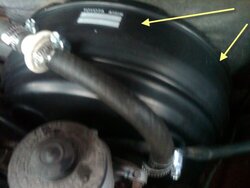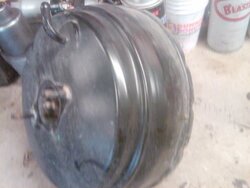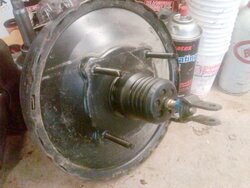Hello
Well the vacuum booster part was ordered. Still waiting for it to come in.
So in summary the best way to fix this issue is by starting with the cheapest parts first.
Toyota CEL Check Engine Light Error Code P0171
Here is the way I should have gone.
1. Engine Vacuum Lines
a. Check or replace the two vacuum lines that go from the engine to the vacuum reserve canister under the battery.
You can use American 5/32 line but if your can get the smaller outside diameter foreign line, the engine holding clips will still work and keep the line away from the hot motor.
b. Check or replace the vacuum booster line from the engine to the vaccuum booster behind the master cylnder.
American 3/8 Vacuum booster hose will work fine.
c. Check all other engine vacuum lines but the above two are the common cause.
2. MAF -Mass Air Flow Sensor.
Make sure you have the additional error codes below. Use OEM because a refurbished part will not give the performance!
P0100 - Air Flow Meter
P0110 - Air Flow Malfunction
Toyota OEM MAV part is $231.00 and makes the car perform like new, but the Re-furbished MAV for $70.00 will give more trouble!
3. Flex Line Exhaust Leak before the down stream O2 Sensor.
Should also get a P0420 error code to turn the light on.
Aftermarket part is $50.00 while the OEM Toyota part is part of the catalytic converter and costs $2,000.00
It must be done anyway for inspection if there is an exhaust leak here. The aftermarket works fine.
4. Low Fuel Pressure
Replace Toyata inline fuel filter on the driver's side inside front fender near the battery.
Toyota style replacement $65.00 at auto parts store. You can probably install an inexpensive inline real cheap here!
This is not so easy since the metal fuel line screws right into the filter!
The easiest way is to cut the fuel line and remove the other side which is a rubber hose.
Install the new Fuel filter by unscrewing the old line from the old filter and screwing it onto the new filter.
Then add a rubber fuel line to connect the severed ends together!
5. Misfire
Replace all spark plugs and wires. The car will run better if they are old anyway.
My wires crumbled from being old and brittle!
6. Vacuum Booster Behind the Master Brake Cylinder.
Before replacing this part there are 2 simple tests to make sure it is bad.
A. When driving and stepping on the brakes you will hear a hiss sound of the leaking air.
B. After turning the key off the brake Pedal will not press down easily one last time!
Compare with a working car and you will feel the difference!
Aftermarket booster is $500.00 and made to last a long time OEM Toyota is $900.00 and obviously does not last long!
7. Replace O2 Sensors. You also get better gas mileage! After market O2 sensors made for Toyota usually work.
Replace the 2 upstream sensors on the exhaust manifolds
Replace the 1 downstream O2 sensor after the catalytic converter. (You can use a Dummy Sensor here if you can find one!)
Nice removal tool that works with an Air Chisel!
 http://www.thetoolwarehouse.net/p-3128-lisle-43900.aspx
http://www.thetoolwarehouse.net/p-3128-lisle-43900.aspx
Well the vacuum booster part was ordered. Still waiting for it to come in.
So in summary the best way to fix this issue is by starting with the cheapest parts first.
Toyota CEL Check Engine Light Error Code P0171
Here is the way I should have gone.
1. Engine Vacuum Lines
a. Check or replace the two vacuum lines that go from the engine to the vacuum reserve canister under the battery.
You can use American 5/32 line but if your can get the smaller outside diameter foreign line, the engine holding clips will still work and keep the line away from the hot motor.
b. Check or replace the vacuum booster line from the engine to the vaccuum booster behind the master cylnder.
American 3/8 Vacuum booster hose will work fine.
c. Check all other engine vacuum lines but the above two are the common cause.
2. MAF -Mass Air Flow Sensor.
Make sure you have the additional error codes below. Use OEM because a refurbished part will not give the performance!
P0100 - Air Flow Meter
P0110 - Air Flow Malfunction
Toyota OEM MAV part is $231.00 and makes the car perform like new, but the Re-furbished MAV for $70.00 will give more trouble!
3. Flex Line Exhaust Leak before the down stream O2 Sensor.
Should also get a P0420 error code to turn the light on.
Aftermarket part is $50.00 while the OEM Toyota part is part of the catalytic converter and costs $2,000.00
It must be done anyway for inspection if there is an exhaust leak here. The aftermarket works fine.
4. Low Fuel Pressure
Replace Toyata inline fuel filter on the driver's side inside front fender near the battery.
Toyota style replacement $65.00 at auto parts store. You can probably install an inexpensive inline real cheap here!
This is not so easy since the metal fuel line screws right into the filter!
The easiest way is to cut the fuel line and remove the other side which is a rubber hose.
Install the new Fuel filter by unscrewing the old line from the old filter and screwing it onto the new filter.
Then add a rubber fuel line to connect the severed ends together!
5. Misfire
Replace all spark plugs and wires. The car will run better if they are old anyway.
My wires crumbled from being old and brittle!
6. Vacuum Booster Behind the Master Brake Cylinder.
Before replacing this part there are 2 simple tests to make sure it is bad.
A. When driving and stepping on the brakes you will hear a hiss sound of the leaking air.
B. After turning the key off the brake Pedal will not press down easily one last time!
Compare with a working car and you will feel the difference!
Aftermarket booster is $500.00 and made to last a long time OEM Toyota is $900.00 and obviously does not last long!
7. Replace O2 Sensors. You also get better gas mileage! After market O2 sensors made for Toyota usually work.
Replace the 2 upstream sensors on the exhaust manifolds
Replace the 1 downstream O2 sensor after the catalytic converter. (You can use a Dummy Sensor here if you can find one!)
Nice removal tool that works with an Air Chisel!
 http://www.thetoolwarehouse.net/p-3128-lisle-43900.aspx
http://www.thetoolwarehouse.net/p-3128-lisle-43900.aspx





